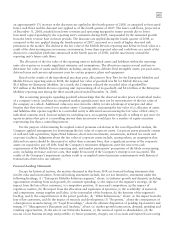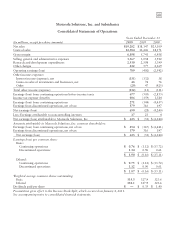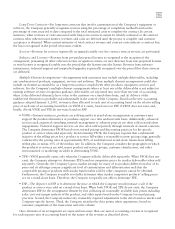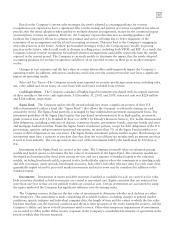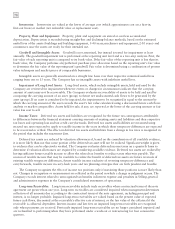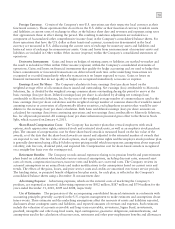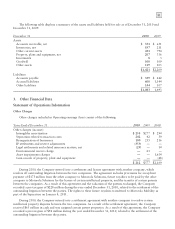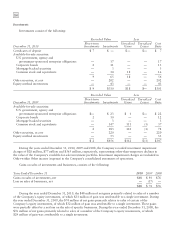Motorola 2010 Annual Report Download - page 82
Download and view the complete annual report
Please find page 82 of the 2010 Motorola annual report below. You can navigate through the pages in the report by either clicking on the pages listed below, or by using the keyword search tool below to find specific information within the annual report.
74
expected to close in the first quarter of 2011, subject to the satisfaction of closing conditions, including receipt of
regulatory approvals. Based on the terms and conditions of the sale agreement, certain assets, including
$150 million of accounts receivable, the Company’s iDEN infrastructure business and substantially all the patents
related to the Company’s wireless network infrastructure business, are excluded from the Transaction.
Beginning in the third quarter of 2010, the results of operations of the portions of the Networks business
included in the Transaction are reported as discontinued operations. Certain Corporate and general costs which
have historically been allocated to the Networks business will remain with the Company after the sale of the
Networks business.
The operating results of the Company’s iDEN infrastructure business and certain licensing activity generally
related to the Networks business are also now being reported as part of the Enterprise Mobility Solutions segment.
The Corporate and general costs which have historically been allocated to the Networks business are allocated to
the Enterprise Mobility Solutions segment. Additionally, the results of operations of previously disposed businesses,
which were deemed to be immaterial at the time of their disposition, have been reclassified from the Enterprise
Mobility Solutions segment to discontinued operations. These businesses include: (i) an Israel-based wireless
network operator, (ii) the biometrics business, and (iii) Good Technology. The assets and liabilities of the Networks
business which are being sold to NSN, as well as the assets and liabilities of the previously disposed businesses
recorded by the Company prior to the closing of the underlying transactions, are reported as assets and liabilities
held for sale. All previously reported financial information has been revised to conform to the current presentation.
Revenue Recognition
In October 2009, the Financial Accounting Standards Board (“FASB”) issued new guidance which amended the
accounting standards for revenue arrangements with multiple deliverables. The new guidance changes the criteria
required to separate deliverables into separate units of accounting when they are sold in a bundled arrangement and
requires an entity to allocate an arrangement’s consideration using estimated selling prices (“ESP”) of deliverables if
a vendor does not have vendor-specific objective evidence of selling price (“VSOE”) or third-party evidence of
selling price (“TPE”). The new guidance also eliminates the use of the residual method to allocate an arrangement’s
consideration.
In October 2009, the FASB also issued new guidance to remove from the scope of software revenue recognition
guidance tangible products containing software components and non-software components that function together to
deliver the tangible product’s essential functionality.
The new accounting guidance is effective for revenue arrangements entered into or materially modified after
June 15, 2010. The standards permit prospective or retrospective adoption as well as early adoption. The Company
elected to early adopt this guidance at the beginning of its first quarter of fiscal 2010 on a prospective basis for
applicable arrangements that were entered into or materially modified after January 1, 2010.
The Company’s material revenue streams are the result of a wide range of activities, from the delivery of
stand-alone equipment to custom design and installation over a period of time to bundled sales of devices,
equipment, software and services. The Company enters into revenue arrangements that may consist of multiple
deliverables of its product and service offerings due to the needs of its customers. Additionally, many of the
Company’s products have both software and non-software components that function together to deliver the
product’s essential functionality. The Company recognizes revenue when persuasive evidence of an arrangement
exists, delivery has occurred, the sales price is fixed or determinable, and collectibility of the sales price is reasonably
assured. In addition to these general revenue recognition criteria, the following specific revenue recognition policies
are followed:
Products and Equipment—For product and equipment sales, revenue recognition generally occurs when
products or equipment have been shipped, risk of loss has transferred to the customer, objective evidence exists that
customer acceptance provisions have been met, no significant obligations remain and allowances for discounts, price
protection, returns and customer incentives can be reliably estimated. Recorded revenues are reduced by these
allowances. The Company bases its estimates of these allowances on historical experience taking into consideration
the type of products sold, the type of customer, and the specific type of transaction in each arrangement. Where
customer incentives cannot be reliably estimated, the Company recognizes revenue at the time the product sells
through the distribution channel to the end customer.



